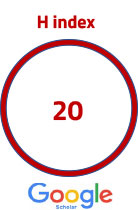| Acceptance rate | 46% |
|---|---|
| Time to first decision | 6 months* |
| Time to decision with review | 50 days* |
*Approximate number of days
**The days mentioned above are averages and do not indicate exact durations. The process may vary for each article.
ACTA Pharmaceutica Sciencia
2022 , Vol 60 , Num 3
Phytochemistry and Antibacterial Efficacy of Northeastern Pakistani Artemisia rutifolia Stephan ex Spreng. Extracts against Some Clinical and Phyto-pathogenic Bacterial strains
1 Food and Biotechnology Research Centre, Pakistan Council of Scientific and Industrial Research (PCSIR) Laboratories Complex, Ferozepur Road, Lahore 54600 Pakistan2 Department of Biotechnology, Faculty of Life Sciences, University of Okara, Okara 56130 Pakistan
3 Department of Biological Sciences, International Islamic University Islamabad, 44000 Pakistan
4 Department of Biosciences, COMSATS University Islamabad, 44000 Pakistan
DOI : 10.23893/1307-2080.APS.6017 Viewed : 10630 - Downloaded : 2878 Recently, most researches have focused on the biological activities of the extracts obtained from different Artemisia species due to the presence of essential compounds with strong activity against some gram-negative and gram-positive bacteria. In this study, five extracts of Artemisia rutifolia Stephan ex Spreng. from the northeastern Gilgit-Baltistan region of Pakistan were analyzed for total flavonoid and total phenolic contents and their antibacterial activities against some clinical and phyto-pathogenic bacterial strains were assessed with agar disk diffusion method. Results indicated that the methanol, ethanol, chloroform, ethyl acetate and n-hexane extracts of A. rutifolia are rich in flavonoids and phenols and all the tested extracts showed the broad spectrum growth inhibition of the tested gram positive (Bacillus subtilis and Staphylococcus aureus) and gram negative bacterial strains (Escherichia coli and Pseudomonas aeruginosa). Overall, methanol and ethyl acetate extracts showed better activities even at lower concentrations (5 mg/ml) where B. subtilis and P. aeruginosa were the most susceptible strains. Hence, the MICs of these two effective extracts (methanol and ethyl acetate extracts) were tested against most susceptible bacterial strains (B. subtilis and P. aeruginosa) at 1-4 mg/ml conc. Results of MICs showed that both the methanol and ethyle acetat extracts were effective against B. subtilis and P. aeruginosa at 3 and 4 mg/ml concentrations where ethyl acetate extract exhibited higher inhibitory effect than the methanol extract. Therefore, extracts of A. rutifolia could be used as operational sources against pathogenic bacterial diseases. Keywords : Artemisia rutifolia, TFC, TPC, antibacterial activity, minimum inhibition concentrations





